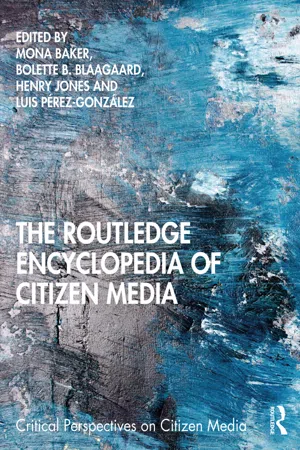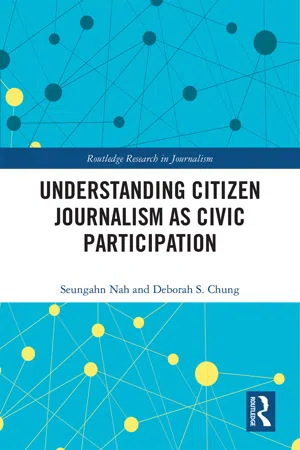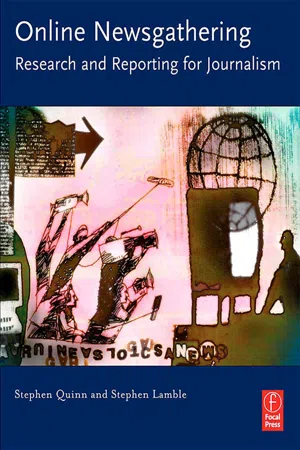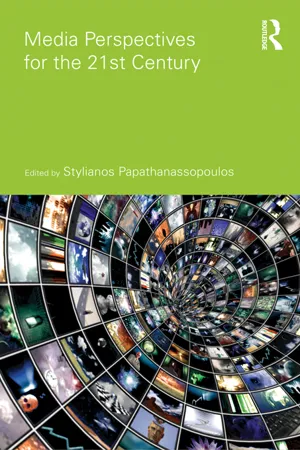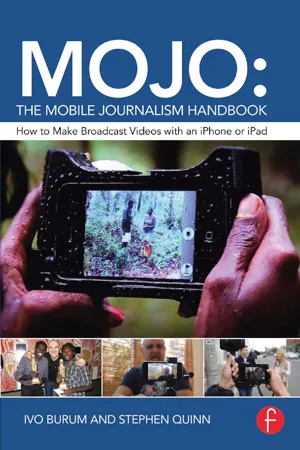Politics & International Relations
Citizen Journalism
Citizen journalism refers to the practice of ordinary individuals, rather than professional journalists, engaging in the collection, reporting, and analysis of news and information. Enabled by digital technology and social media platforms, citizen journalism has the potential to provide diverse perspectives and grassroots coverage of political events, often challenging traditional media narratives and offering a more democratic approach to news dissemination.
Written by Perlego with AI-assistance
8 Key excerpts on "Citizen Journalism"
Learn about this page
Index pages curate the most relevant extracts from our library of academic textbooks. They’ve been created using an in-house natural language model (NLM), each adding context and meaning to key research topics.
- eBook - ePub
- Mona Baker, Bolette B. Blaagaard, Henry Jones, Luis Pérez-González, Mona Baker, Bolette B. Blaagaard, Henry Jones, Luis Pérez-González(Authors)
- 2020(Publication Date)
- Routledge(Publisher)
In Turkey, likewise, the May–July 2013 protests culminating in Taksim Square and Gezi Park were extensively reported on by activists who attracted global attention to the events through Twitter hashtags such as #OccupyGezi and #DirenGeziParki. In Brazil, citizen reporting drew attention to the mass protests over poverty and abuse of human rights against a background of extravagant expenditure on the FIFA Football World Cup (June–July 2013). Citizen reporting also plays an important part in drawing public attention to mass protests in liberal democracies, where state and private media often turn a blind eye to injustices in order to appease established forms of power, whether they represent state or private interests. Examples here include the riots in London and other parts of the UK in August 2011; the Occupy Wall Street movement in the US in 2011; and the mass protests against unemployment and government cuts in Spain in 2013. In all these cases, it was citizen reporting via social media that attracted international attention to the events.Citizen Journalism acted as a focal point and amplifier in such contexts, exposing underlying social tensions and enabling existing social movements and unions to mobilize. It served a dual purpose, in transnational advocacy as well as local mobilization aimed at re-appropriating public spaces (Cottle and Lester 2011; Gerbaudo 2012; Lievrouw 2011). In other words, while Citizen Journalism (and its intermediation) is predominantly discussed in terms of online communicative networks, it is important not to lose sight of its connection to action, or mobilization in material spaces (transmediation) – from hyperlocal to global contexts (Chouliaraki 2013a; Thorsen 2016). Ordinary citizens also contribute to relief efforts – mapping impact areas, crowdsourcing information about survivors, republishing emergency information and so forth – in what Norris (2017) has termed a form of digital humanitarianism. Here different forms of (typically online) collaboration enable people in disparate locations to form temporal networks that support disaster relief efforts through processing, curating and publishing information pertinent to distant emergencies. Bespoke platforms have also emerged to help facilitate the crowdsourcing of news and dissemination of eyewitness material. One example is Ushahidi , a platform originally designed to capture citizen reports of violence via text message and email in the aftermath of Kenya’s disputed 2007 presidential election. The company has since evolved into a software platform with a reported 125,000 deployments. Bailard and Livingston (2014) found that citizen reporting of electoral abuse or success in the 2011 Nigerian election using the Ushahidi platform was significantly correlated with increased voter turnout, while Barack Obama’s campaign team used Ushahidi during the 2012 US election to manage information collected from its election observers. Ushahidi - eBook - ePub
Citizen Journalism
Practices, Propaganda, Pedagogy
- Melissa Wall(Author)
- 2018(Publication Date)
- Routledge(Publisher)
Some researchers have argued that due to this incoherence we should focus on what citizen journalists do rather than who they are – not the label for the person but the label for the practices in which they engage (Bock, 2012; Domingo & Le Cam, 2016). But even here, there is not a shared meaning. What Citizen Journalism is depends on the local context in which it is produced as well as the contexts of reception. Citizen Journalism in different regions of the world, including those countries with a lack of information freedom under oppressive governments, has taken root in different soil. Consider the ways Citizen Journalism in non-Western countries has challenged authoritarian rule, sometimes becoming an identity used to represent resistance to the powers that be in ways that could prove dangerous for those who are so labeled. This is well illustrated with the Citizen Journalism produced during the Arab Spring. Prado (2017) argues that much Citizen Journalism in the Global South “privileges the perspective of communities and populations underrepresented in legacy news media accounts: this reporting may reaffirm cultural identity or chronicle the everyday life of rural, isolated or disenfranchised populations, or of cultures nearing extinction” (p. 89). Of course, these same efforts of resistance and representation can be found in the West. Thus, there is no one form of Citizen Journalism but many iterations based on the context and actors involved. Around the world and even within individual countries, Citizen Journalism is not a unified set of practices. While photographs of sunsets or comments about celebrities may be considered forms of Citizen Journalism in some contexts, in this volume, part of the focus is on forms of activist-oriented Citizen Journalism. Such content is often produced within a network of like-minded others, whose goals are to create social and political change. Thus, I define Citizen Journalism here as the production of original media content by amateurs and other in-betweeners that aims to contribute to the building of community and sometimes to social change.Placing Citizen Journalism
Citizen Journalism is by now a well-researched topic with many of the key issues debated and discussed across various volumes and special issues (see Allan, 2015; Allan & Thorsen, 2009; Rosenberry & St. John, 2009; Thorsen & Allan, 2014; Wall, 2012, 2016, 2017). Such examinations frequently focus on the reception of Citizen Journalism by professional journalists, stressing the ways mainstream journalism has well-developed routines for incorporating Citizen Journalism into its news (Borger, Van Hoof, & Sanders, 2016b; Canter, 2013; Domingo, 2011; Robinson, 2009). Some research finds citizens are gladly invited to participate in the professional media outlets’ production of the news, although oftentimes within highly structured forms used to segregate or diminish citizen contributions (Wahl-Jorgensen, 2015; Li & Hellmueller, 2016). Other analysis suggests that there is actually not so much citizen involvement in mainstream news but instead more of an illusion of participation that helps professional journalists to maintain real control over the news (Jönsson & Örnebring, 2011; Karlsson, 2011; Karlsson, Bergström, Clerwall, & Fast, 2015). In many cases, the aim appears to be to introduce such limited participation that it does not lessen the authority of the professionals (Singer, 2015). - Seungahn Nah, Deborah S. Chung(Authors)
- 2020(Publication Date)
- Routledge(Publisher)
Thus, Citizen Journalism can encompass a variety of activities entailing a range of citizen efforts through local or national news media, either personal or pro-am collaborations (Allan, 2013; Franklin & Carlson, 2010; Nah, 2008). It can capture a single moment, be intermittent or random, or even be more long-term, regular coverage (Wall, 2015). These activities can be described as civic and participatory activities contributing to various online public spheres. Citizens contribute through simple fact checking, correction, and providing supplemental news content found lacking in mainstream news coverage (Outing, 2005). Citizens may also function as an added work force to news organizations by aiding in the collection, reporting, and also dissemination of information, thus contributing to the conversation of democracy (Farinosi & Treré, 2014; Forde, Foxwell, & Meadows, 2003).Therefore, we define Citizen Journalism broadly as activities that contribute to the public sphere through the sharing and expression of news content, including comments, photos/videos, and news stories and other communication practices (Chung et al., 2018; Fico et al., 2013; Lacy, Duffy, Riffe, Thorson, & Fleming, 2010; Nah et al., 2015). Citizen Journalism is, thus, approached as a form of civic participation entailing (a) citizen contributions (e.g., citizen response or submissions) to mainstream and professional news media sites and (b) citizen contributions (citizen-produced content) to alternative and citizen news sites.For example, citizens, or amateurs, submit and share news content, such as text, video, and audio, on professional news media sites (Wall, 2015, p. 2)—sometimes individually and sometimes together with professionals (i.e., pro-am journalism). Through such activities, citizens may challenge the “professional logic of control” (Lewis, 2012, p. 839) of mainstream news although the hegemonic control over the information domain (i.e., gatekeeping) is still largely in the hands of professional journalists (Lewis, 2012; Nah et al., 2015). However, unlike on mainstream news media sites, Citizen Journalism-oriented sites retain control over all stages of content production, publication, and dissemination (Nip, 2006, p. 218), providing them with more independent influence on their work.- eBook - ePub
Online Journalism Ethics
Traditions and Transitions
- Cecilia Friend, Jane Singer(Authors)
- 2015(Publication Date)
- Routledge(Publisher)
“This isn’t a toe in the water,” he says. “It’s a fundamental realignment” of BBC’s citizen media strategy. Citizen reporting complementing professional reporting is here to stay, he notes. It is only a matter of figuring out how to do it better and deal with the issues of authenticity. 3 Citizen Journalism initiatives go beyond witness reports, of course. Citizen Journalism is based in part on the idea that news should be a conversation rather than a monologue from professional journalists and mainstream news organizations. It strives to give the “former audience” a say in deciding what constitutes news at a time when many citizens are skeptical or distrustful of professional journalists. It welcomes customers and consumers as participants in the news process. The pioneers and champions of the movement assert the same fundamental ethical principle as traditional journalists: The purpose of news is to enable citizens to have the information needed to more fully participate in society and to be free and self-governing. “This news revolution, ultimately, is about citizenship,” says Dan Gillmor, author of We the Media and a pioneer of the grassroots media movement. 4 The more that citizens participate in the news, the more deeply engaged they tend to become in the democratic process. We saw in Chapter 5 how blogs have given citizens the ability to publish their own views on the issues of the day. Online users also participate in developing news stories for traditional news organizations as well as writing and editing their own Citizen Journalism sites. The symbiotic relationship between professional and citizen journalists that Sambrook describes leads to questions about the role and responsibility of mainstream news organizations that invite and host citizen contributors - Stephen Quinn, Stephen Lamble(Authors)
- 2012(Publication Date)
- Routledge(Publisher)
4Citizen Journalism and Audience-Generated Content
The first issue we need to discuss is a defintion of the terms that start this chapter. Citizen Journalism is a broad term whose meaning is still shifting. We will be quite specific. It occurs in two forms. The first is when members of the public, who are not professional journalists, contribute content that is published on traditional media. This form of Citizen Journalism reflects one of the basic rules of media known as media-morphosis. New media do not replace old media. Traditional media change to absorb the best of new media (Fidler 1997). This form of Citizen Journalism includes things like publication of photographs or video taken by amateurs who happened to be at the right place at the right time, such as the London bombings in July 2005. It could also include comment and opinion by a blogger that later appears on a mainstream media news site. Or it could occur when people offer first-hand accounts of events they were involved in, such as the tsunamis on December 26, 2004. Most of the time these people are not paid for their contribution. Citizen Journalism in this context is nearly always contextualized, edited, and proofread by professional journalists. The other term used for citizen reporting is “participatory” journalism, but this book will stick with citizen for consistency.OhmyNews is one of the pioneers of this form of Citizen Journalism. The site had more than 50,000 citizen reporters as of March 2007, but professional editors still screened the content submitted. Jean Min of OhmyNews International said every story went through an extensive screening and copyediting process before it was published. Citizen reporters “find their stories more polished after proofreading and editorial retouching by professionals.” Editors at OhmyNews spent time educating aspiring citizen journalists. “We regularly invite them to our newsroom and give them ‘Journalism 101’ classes” (personal communication 2007). OhmyNews editors reject about 3 out of 10 contributions each day because of poor writing, factual errors, or lack of news value (Min 2005: 17; Min 2007).- eBook - ePub
- Stylianos Papathanassopoulos(Author)
- 2011(Publication Date)
- Routledge(Publisher)
7Bruns (2008 ) dates Citizen Journalism to activists’ proactive and highly networked organizing of Indymedia before the 1999 World Trade Organization meeting in Seattle. The pioneering South Korean site OhmyNews launched in 2000; by 2009, some 70,000 citizens had written stories that were edited by volunteer editors (Woyke, 2009 ). OhmyNews later launched Citizen Journalism sites in English and Japanese. All its citizen reporters must abide by a strict Code of Ethics, whose first principle is that everyone must work in the spirit that ‘all citizens are reporters’, and identify themselves as citizen reporters while covering stories. NewAssignment.net sought to show that ‘open collaboration over the Internet among reporters, editors and large groups of users can produce high-quality work that serves the public interest, holds up under scrutiny, and builds trust’ (Rosen, 2006 ).The terminology of Citizen Journalism is problematic, perhaps reflecting both semantic quibbles and substantive philosophic debates. The terminological turmoil may also highlight a useful willingness to experiment; emerging through trial and error, Citizen Journalism refers to a huge range of structures and models, with very different practices and ambitions. Some of what goes by this term is sporadic and happenstance, and turned over to legacy media. This end of the spectrum includes both highly ‘accidental journalism’ (the 30 seconds of film capturing the assassination of President Kennedy sold to Life Magazine for $150,000) but also citizens’ intentional undertaking of a ‘watchdog’ role by sharing pictures and video of police brutality at the 2006 May Day immigrant protests in Los Angeles and the Bay Area police shooting in 2009 of an unarmed man. Within 24 hours of the 2005 London underground bombings, the BBC received 1,000 stills and videos, 3,000 texts and 20,000 emails. This outpouring convinced BBC management: ‘[W]e had to change. We would need to review our ability to ingest this kind of material and our editorial policies to take account of these new forms of output’ (Boaden, 2008 - Melissa Wall, Melissa Wall(Authors)
- 2020(Publication Date)
- Routledge(Publisher)
• Critical research reminds us that unqualified claims that Citizen Journalism levels the playing field between amateurs and professionals grossly underestimates the ways news comes to the public’s notice, downplaying the importance of professional amplification. Likewise, the appropriation of citizen media content appears to have been enhanced by the rise of social and other forms of online participatory media.• Issues surrounding the ethics of working with citizen journalists are increasingly difficult to ignore even as traditional news continues to put citizen reporters into danger in order to score coverage of hard-to-access news. Research has not given enough consideration to this aspect of collaboration.• Citizen participation is clearly happening in meaningful forms when those opportunities are provided by organizations motivated by civic, at least as much as if not more so, than commercial concerns. In fact, based on the research presented in this issue, an argument can be made that large-scale traditional news organizations may not be the best locations for meaningful citizen participation in the news. That is to say, there may be not enough oxygen in industrial news for authentic participatory Citizen Journalism to truly breathe.• A key means of fostering the development of Citizen Journalism appears to be through establishing on-going, face-to-face training. In other words, some sort of real-world, human-centered scaffolding seems necessary to successfully develop and support public voices, particularly the voices of those who tend to face societal exclusion (Waisbord 2014).In sum, the research in this special issue suggests that citizen participation in the production of news, whatever it is labeled (Citizen Journalism, participatory journalism, engagement, etc.), has created new approaches in newsrooms, journalism training projects and journalism research, but that all of these sectors must continue to respond and adapt. Whether pessimists are correct that corporations have already normalized and tamed the threat to their authority or the optimists who present evidence of ever-more sophisticated professional–amateur collaboration does not matter so much as our acceptance that the relationships are, and will permanently remain, fluid and contingent for the foreseeable future.- eBook - ePub
MOJO: The Mobile Journalism Handbook
How to Make Broadcast Videos with an iPhone or iPad
- Ivo Burum, Stephen Quinn(Authors)
- 2015(Publication Date)
- Routledge(Publisher)
In conclusion, sustained democracy requires freedom of expression and the protection of an effective public sphere supported by a free press. Without this it can be argued that revolutions only pave the way for another repressive state. Once reporters have soaked up the ambient journalism of revolution and moved on, digital media scholar Associate Professor Alfred Hermida believes one question still needs to be answered. How can new media be used to do more than initiate revolution (which is the “sexy” part that mainstream media usually focuses on)? Indeed, how can it be used to build civil society with long-term heterogeneous visions of a democratic public sphere? In our online world with its networked communications sphere this is an issue that concerns us all. Throughout this book we will discuss the skills and the technologies required to better purpose UGC into more purposeful UGS, produced by professional journalists, students and citizens, to create a more diverse and less marginalized public sphere.One aspect of this overlapping model described above is its impact on the labor market. Overlapping spheres of labor can initially create exclusion, in particular in new media models, where exclusion can be a result of age, ethnicity and/or geography (Neilson and Rossiter 2005). Job losses can also be the result of new technology that requires shifts in techne , which may be a barrier and lead to reluctance to embrace new communications. Addressing this in the news business is paramount and this is discussed in the next chapter.Define journalism.The creation of user-generated content is also often referred to as Citizen Journalism. In this sense, the user or creator of the content, the citizen, generates news-type information and places it on blogs or gives the content to a mainstream media organization. Where does the journalism occur?What is Citizen Journalism? Why do people become involved in Citizen Journalism? Can Citizen Journalism be defined as something that people without professional journalism training do and, if so, should it be?Notes
1 Even though freedom of speech is guaranteed in the Egyptian constitution.2 Members of the 2000 Syrian revolt against declining standards of living and oppression met in private houses (salons) to discuss reform mobilized around a number of demands expressed in the “Manifest 99,” a document signed by prominent intellectuals.3 “Precarity” is used to describe the material and psychological state resulting from high levels of social unpredictability and low levels of labor security.References
Bowman, Shayne, and Chris Willis. 2003. We Media: How Audiences Are Shaping the Future of News and Information . Ed, J. D. Lasica. The Media Center, The American Press Institute. www.hypergene.net/wemedia/weblog.php
